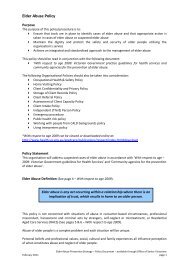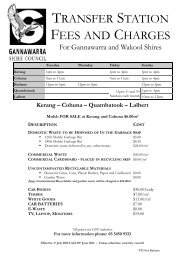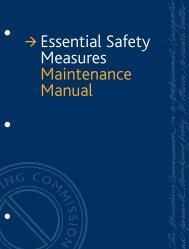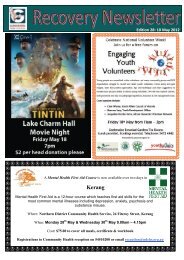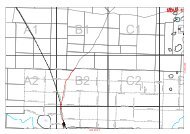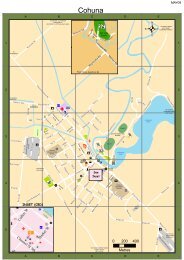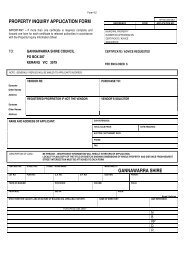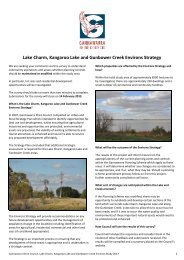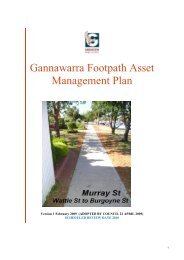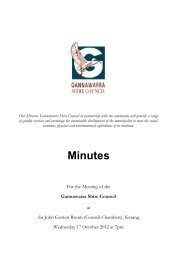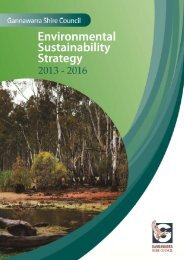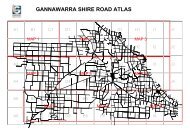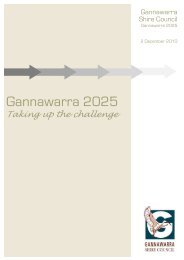Southern Loddon Mallee Regional Strategic Plan 1 - Macedon ...
Southern Loddon Mallee Regional Strategic Plan 1 - Macedon ...
Southern Loddon Mallee Regional Strategic Plan 1 - Macedon ...
Create successful ePaper yourself
Turn your PDF publications into a flip-book with our unique Google optimized e-Paper software.
Basis for action:<br />
Our region has many small towns each with their distinct identity,<br />
and varying levels of community infrastructure. Residents of<br />
these towns access the larger settlements for a range of services<br />
including employment health and education. It is important that<br />
those in small towns have access to services by retaining existing<br />
infrastructure in towns, bringing visiting services in to towns, or<br />
providing appropriate transport services so that residents can<br />
access larger towns. Without this intervention, levels of socioeconomic<br />
disadvantage will increase and result in poorer health<br />
and well-being, lack of access to employment and reduced<br />
community vitality and viability. The community planning process<br />
develops local solutions that account for different communities’<br />
resources, demographics, interests and needs.<br />
Supporting our small towns<br />
Improving social equity across the region and addressing social<br />
disadvantage is a big challenge for our region. Population growth<br />
in more advantaged parts of the region will only exacerbate<br />
existing differences in socio-economic prosperity, particularly in<br />
small towns across the region. Structural adjustment in agriculture<br />
(a key sector in <strong>Loddon</strong> Shire) and the continued loss of young<br />
adults as they move to larger centres or cities within or beyond the<br />
region also threaten to widen the gap between advantaged and<br />
disadvantaged communities.<br />
The VCEC A State of Liveability: An Inquiry into Enhancing Victoria’s<br />
Liveability (2009) report suggests that two factors which detract<br />
from liveability in provincial Victoria are a lack of access to services<br />
and infrastructure and indifferent communication technology. This<br />
characterises rural areas and some of our smaller towns who are<br />
experiencing declining levels of service and increasing per capita<br />
costs of service provision. Other groups, including culturally and<br />
linguistically diverse (CALD) communities, Aboriginal and Torres<br />
Strait Islander people, the elderly, disabled or youth experience<br />
these challenges in accessing services, even in some of the larger<br />
population centres.<br />
The process of identifying priorities for service provision must<br />
engage the relevant communities. Sharing experiences in<br />
community engagement and service planning at a regional<br />
level will enable successful examples to be applied to other<br />
communities.<br />
One initiative currently being implemented is the new<br />
representative arrangement for Aboriginal and Torres Strait Islander<br />
Victorians - this includes representation at both the community<br />
(Local Indigenous Networks) and the regional level (<strong>Regional</strong><br />
Indigenous Council). As these mechanisms involve planning by<br />
Aboriginal and Torres Strait Islander people they can become an<br />
important link for Aboriginal and Torres Strait Islander communities<br />
to participate in place-based community planning.<br />
Leadership<br />
Building the capacity of community leaders and volunteer<br />
organisations is fundamental in empowering and building<br />
community strength and resilience.<br />
Facilitating increased community inclusion is important to foster<br />
a more tolerant and welcoming society in the face of change.<br />
Actions aim to develop the capacity of the community, strengthen<br />
networks and ensure that as new migrant groups arrive in<br />
the region, they are welcomed and their contribution to the<br />
community and economy optimised to increase the overall social<br />
capital of the community.<br />
Our health and wellbeing<br />
Bendigo is home to a depth of health infrastructure, such as<br />
Bendigo hospital, which provides high quality care and a diversity<br />
of services offering an alternative to Melbourne for health care.<br />
Other towns such as Castlemaine and Kyneton have existing health<br />
infrastructure which service the surrounds with opportunity to<br />
establish a strong interconnected health sector in our region.<br />
Health status varies across our region due to socio-economic<br />
and environmental factors, including income, educational and<br />
employment opportunities, and access to services. Health typically<br />
deteriorates with distance from metropolitan areas. Smaller and<br />
more remote communities and disadvantaged groups with limited<br />
access to transport tend to experience poorer health outcomes.<br />
The Bendigo <strong>Loddon</strong> Primary Care Partnership (including the<br />
Greater Bendigo and <strong>Loddon</strong> local government areas) and the<br />
Central Victorian Health Alliance (including the Central Goldfields,<br />
<strong>Macedon</strong> Ranges and Mt Alexander local government areas)<br />
provide a network of community service, health organisations and<br />
local government agencies across the region. These PCPs work<br />
collaboratively to improve health and wellbeing of people in the<br />
region and to reduce unnecessary use of hospital, medical and<br />
residential services.<br />
Infrastructure and critical services in smaller regional hospitals<br />
must be maintained to ensure access in smaller communities<br />
and by disadvantaged groups, particularly those without access<br />
to transport. These services must also connect with the regional<br />
centre of excellence in Bendigo, including via ‘virtual’ services<br />
accessed via broadband technology.<br />
Access to services<br />
Our region is renowned for high quality health care which assists<br />
in attracting and retaining residents. Bendigo Hospital is our major<br />
regional public provider, with smaller-scale hospitals and health<br />
care practitioners providing services in smaller communities.<br />
The first stage of a $55 million upgrade the Bendigo Hospital<br />
is in progress. A further $473 million in funding to construct a<br />
new hospital, including additional inpatient beds, a refurbished<br />
ambulatory centre and additional radiotherapy and oncology<br />
services was announced in the 2010 Victorian state budget.<br />
Continued investment in infrastructure is needed to ensure<br />
Bendigo Hospital continues to develop as a regional health care<br />
centre of excellence, provides high quality hospital services for the<br />
regional community and continues to build linkages with health<br />
education and research.<br />
In keeping with its regional charter, further investment is also<br />
needed to provide accommodation and support services to<br />
patients and their families from elsewhere in the region (and<br />
beyond). Investment in other health facilities around the region<br />
will also be required and creative initiatives are needed to attract<br />
and retain local practitioners to our region.<br />
Our ageing population<br />
Demand for hospital services is expected to rise significantly over<br />
the next ten years as a result of population ageing, the rising levels<br />
of preventable chronic disease and disadvantage. The greatest<br />
increase in resident demand for hospital services will come from<br />
older people who need them more often and for longer periods.<br />
Continued investment in infrastructure and services is needed<br />
to ensure hospital and other health care facilities in our regional<br />
centres and smaller towns provide an appropriate level of service,<br />
particularly to meet the needs of our ageing communities.<br />
<strong>Southern</strong> <strong>Loddon</strong> <strong>Mallee</strong> <strong>Regional</strong> <strong>Strategic</strong> <strong>Plan</strong> 17



